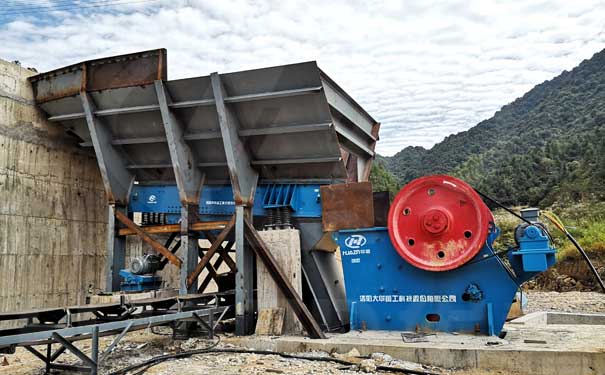How to judge whether a sand and gravel production line meets energy-saving, high-efficiency, green and environmental protection and has a rate of return? It mainly depends on whether the configuration of the sand production line is reasonable. An excellent configuration plan can not only effectively increase the output of the production line, but also create economic benefits for customers. Next, let's understand the process flow and site selection of the sand production line.
1. Rough stone feeding steps: the blasted rough stone is sent to the vibrating feeder through a loading truck from the mountain through a detonator, industrial explosives, etc.
2. First and second crushing steps: the vibrating feeder uniformly transports the raw stone to the first crushing jaw crusher. The jaw crushing is the first crushing or coarse crushing. The production line can be designed as a closed loop to achieve the corresponding the size of the stone material size; then the stone material crushed from the jaw crusher is sent to the cone crusher or impact crusher through the belt conveyor for secondary crushing, which is the second crushing.
3. Sand making and screening steps: the stone material after the secondary crushing is transported by the belt conveyor to the sand making machine for fine crushing. The finely crushed material is then screened through the vibrating screen equipment to screen out finished materials of different specifications and sizes. The quality can be cleaned by sand washing machine.
The choice of the site of the sand production line is particularly important in the construction of the sand production line. So how to choose the site of the sand production line?
1. The principle of conservation. When choosing a sand production line site, pay attention to the three principles of economy, convenience and environmental protection. The sand making site should be close to the machine-made sand raw materials, which can shorten the transportation distance and reduce the consumption during transportation; secondly, it is necessary to save the site area and the sand making equipment. The configuration should be reasonable and compact, and intensive production; maximize the use of terrain advantages, for example, you can choose a sloped place, which not only facilitates the transportation of materials, reduces energy consumption, but also saves sand production costs.
2. The principle of facilitation. The site of the sand production line should be located in a convenient place, close to transportation hubs such as railways and highways, which can facilitate the transportation of sand and gravel materials; secondly, choose a place with convenient water and power supply conditions. The production of the sand production line cannot be separated from the support of water and electricity. Therefore, it is necessary to choose places with abundant water sources that can meet the needs of production and daily life; choose places with relatively cheap electricity prices to save capital and reduce sand production.
3. The principle of environmental protection. Environmental protection is an important issue that needs to be considered when selecting the site of a sand production line. Only when the sand production line achieves environmental protection can it achieve sustainable development, reduce environmental pollution problems, and protect the ecological environment of sand production. The site of the sand production line should be far away from residential areas, and it is best to treat wastewater and dust to avoid noise, dust, and sewage pollution.



